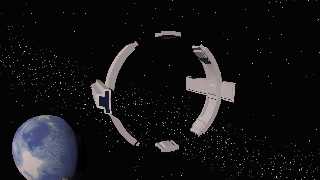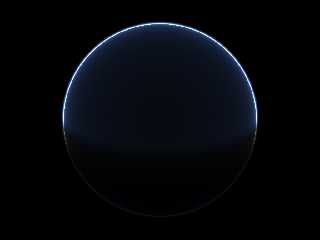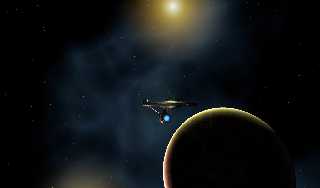 |
 |
|
 |
|
 |
|  |
|  |
|
 |
|
 |
|  |
|  |
|
 |
Partially solved my atmosphere problem... next part is detailing the gate.
I'm also thinking about adding a moon.
Render time: ~ 14h 8m
Comments, suggestions?
A.D.B.
Post a reply to this message
Attachments:
Download 'workshop.png' (263 KB)
Preview of image 'workshop.png'

|
 |
|  |
|  |
|
 |
|
 |
|  |
|  |
|
 |
> Partially solved my atmosphere problem... next part is detailing the gate.
>
> I'm also thinking about adding a moon.
>
> Render time: ~ 14h 8m
>
> Comments, suggestions?
>
> A.D.B.
Going on nicely.
A suggestion: Comment out the planet while working on the gate. It will
be much faster to test.
Alain
Post a reply to this message
|
 |
|  |
|  |
|
 |
|
 |
|  |
|  |
|
 |
Anthony D. Baye escreveu:
> Partially solved my atmosphere problem... next part is detailing the gate.
>
> I'm also thinking about adding a moon.
>
> Render time: ~ 14h 8m
>
> Comments, suggestions?
completely unacceptable render time for such a flat, untextured scene.
Specially considering space scenes should not even need radiosity for
GI... hope you're rendering in a smartphone. :p
--
a game sig: http://tinyurl.com/d3rxz9
Post a reply to this message
|
 |
|  |
|  |
|
 |
|
 |
|  |
|  |
|
 |
nemesis wrote:
> completely unacceptable render time for such a flat, untextured scene.
well I suppose the planet is using a lot of media although
it may be overkill at such a scale. I wonder if SSLT would be
appropriate for distant planetary views where the atmosphere
appears to be very thin.
> Specially considering space scenes should not even need radiosity
I'm not sure about that. Parts of the gate that are pointing
away from the Sun may be indirectly illuminated by opposing parts
that are in sunlight.
Post a reply to this message
|
 |
|  |
|  |
|
 |
|
 |
|  |
|  |
|
 |
Am 30.05.2011 00:35, schrieb Christian Froeschlin:
> well I suppose the planet is using a lot of media although
> it may be overkill at such a scale. I wonder if SSLT would be
> appropriate for distant planetary views where the atmosphere
> appears to be very thin.
I don't think so; the SSLT math presumes that the medium is very "dense".
Post a reply to this message
|
 |
|  |
|  |
|
 |
|
 |
|  |
|  |
|
 |
Christian Froeschlin <chr### [at] chrfr de> wrote:
> nemesis wrote:
>
> > completely unacceptable render time for such a flat, untextured scene.
>
> well I suppose the planet is using a lot of media although
> it may be overkill at such a scale. I wonder if SSLT would be
> appropriate for distant planetary views where the atmosphere
> appears to be very thin.
Are you using scattering media for the atmosphere? I suggest using emissive
media with a gradient map instead. Renders much faster, gives you more artistic
control and looks better as you don't geht a sharp shadow at the terminator.
This is what i've been using:
#declare R0 = 10; // planet radius
#declare ah = 0.25; // atmosphere height
sphere { 0, R0 } // the planet
sphere { // the atmosphere
0, 1 pigment { rgbf 1 } hollow
interior {
media{
emission 2.2*1/255 //scale to need
density {
spherical
density_map {
[ah/(R0+ah)*0.00 rgb < 0, 0, 0>]//sky
[ah/(R0+ah)*0.20 rgb < 9, 10, 18>]
[ah/(R0+ah)*0.30 rgb < 10, 14, 21>]
[ah/(R0+ah)*0.40 rgb < 14, 18, 28>]
[ah/(R0+ah)*0.50 rgb < 20, 23, 38>]
[ah/(R0+ah)*0.55 rgb < 27, 33, 52>]
[ah/(R0+ah)*0.60 rgb < 29, 39, 61>]
[ah/(R0+ah)*0.65 rgb < 30, 45, 74>]
[ah/(R0+ah)*0.70 rgb < 30, 54, 90>]
[ah/(R0+ah)*0.75 rgb < 37, 67,109>]
[ah/(R0+ah)*0.80 rgb < 48, 82,190>]
[ah/(R0+ah)*0.85 rgb < 61, 99,151>]
[ah/(R0+ah)*0.90 rgb < 80,118,171>]
[ah/(R0+ah)*0.95 rgb <104,139,187>]
[ah/(R0+ah)*1.00 rgb <154,173,203>]//ground
}
}
density {
gradient y
translate -y/2
scale 2
density_map {
[0.00 rgb <10, 8, 8>/255]//day side
[0.40 rgb <10, 8, 8>/255]
[0.45 rgb <37, 12, 6>/255]
[0.50 rgb <59, 34, 15>/255]//terminator
[0.55 rgb <66, 58, 56>/255]
[0.60 rgb 0.65]
[1.00 rgb 0.65]//night side
}
}
}
}
scale R0+ah
}
Regards Roman de> wrote:
> nemesis wrote:
>
> > completely unacceptable render time for such a flat, untextured scene.
>
> well I suppose the planet is using a lot of media although
> it may be overkill at such a scale. I wonder if SSLT would be
> appropriate for distant planetary views where the atmosphere
> appears to be very thin.
Are you using scattering media for the atmosphere? I suggest using emissive
media with a gradient map instead. Renders much faster, gives you more artistic
control and looks better as you don't geht a sharp shadow at the terminator.
This is what i've been using:
#declare R0 = 10; // planet radius
#declare ah = 0.25; // atmosphere height
sphere { 0, R0 } // the planet
sphere { // the atmosphere
0, 1 pigment { rgbf 1 } hollow
interior {
media{
emission 2.2*1/255 //scale to need
density {
spherical
density_map {
[ah/(R0+ah)*0.00 rgb < 0, 0, 0>]//sky
[ah/(R0+ah)*0.20 rgb < 9, 10, 18>]
[ah/(R0+ah)*0.30 rgb < 10, 14, 21>]
[ah/(R0+ah)*0.40 rgb < 14, 18, 28>]
[ah/(R0+ah)*0.50 rgb < 20, 23, 38>]
[ah/(R0+ah)*0.55 rgb < 27, 33, 52>]
[ah/(R0+ah)*0.60 rgb < 29, 39, 61>]
[ah/(R0+ah)*0.65 rgb < 30, 45, 74>]
[ah/(R0+ah)*0.70 rgb < 30, 54, 90>]
[ah/(R0+ah)*0.75 rgb < 37, 67,109>]
[ah/(R0+ah)*0.80 rgb < 48, 82,190>]
[ah/(R0+ah)*0.85 rgb < 61, 99,151>]
[ah/(R0+ah)*0.90 rgb < 80,118,171>]
[ah/(R0+ah)*0.95 rgb <104,139,187>]
[ah/(R0+ah)*1.00 rgb <154,173,203>]//ground
}
}
density {
gradient y
translate -y/2
scale 2
density_map {
[0.00 rgb <10, 8, 8>/255]//day side
[0.40 rgb <10, 8, 8>/255]
[0.45 rgb <37, 12, 6>/255]
[0.50 rgb <59, 34, 15>/255]//terminator
[0.55 rgb <66, 58, 56>/255]
[0.60 rgb 0.65]
[1.00 rgb 0.65]//night side
}
}
}
}
scale R0+ah
}
Regards Roman
Post a reply to this message
Attachments:
Download 'atmosphere.jpg' (88 KB)
Preview of image 'atmosphere.jpg'

|
 |
|  |
|  |
|
 |
|
 |
|  |
|  |
|
 |
Hi Anthony,
Since your planet is far away, you may also want to consider using the aoi
pattern to fake an atmospheric glow. Although it doesn't give that soft/hazy
look, it renders very fast. Here's a code snippet and an example of what it
looks like (with the USS Enterprise, of course! :-)
#declare p_planet_atmosphere =
pigment {rgbt <0.5,0.5,0.5,0.5>}; // adjust transparancy component to
change atmospheric translucency
#declare p_planet_atmosphere_glow =
pigment {rgb <0.9,0.95,1>*1.8}; // atmospheric glow
#declare p_planet_atmosphere =
pigment {
aoi
pigment_map {
[0.5 p_planet_atmosphere_glow]
[0.7 p_planet_atmosphere]
}
};
#declare t_planet_atmosphere =
texture {pigment {p_planet_atmosphere}
finish {ambient 0}
}
union {
sphere {0,3 texture {T_Stone22 finish {phong 0 ambient 0 reflection 0}}
} // planet surface
sphere {0,3.0001 texture {t_planet_atmosphere}}
// planet atmosphere
}
// need a bright light to make it glow
---
Rob.
Rob Fitzel
www.fitzel.ca/dart
Post a reply to this message
Attachments:
Download 'aoiatmosphere.jpg' (176 KB)
Preview of image 'aoiatmosphere.jpg'

|
 |
|  |
|  |
|
 |
|
 |
|  |
|  |
|
 |
Nice.
I am still surprised at the render time. My planets with the given *Tek
atmosphere*, render in less than an hour....
Thomas
Post a reply to this message
|
 |
|  |
|  |
|
 |
|
 |
|  |
|  |
|
 |
On 31/05/2011 7:15, RobF wrote:
> Hi Anthony,
>
> Since your planet is far away, you may also want to consider using the aoi
> pattern to fake an atmospheric glow. Although it doesn't give that soft/hazy
> look, it renders very fast. Here's a code snippet and an example of what it
> looks like (with the USS Enterprise, of course! :-)
you could give it a soft/hazy look, even with some atmospheric
discoloration near the terminator:
--- START CODE ---
#version 3.7;
global_settings {
assumed_gamma 1
}
#local SunLocation=<500,300,200>*1000;
camera {
location -z*3
look_at 0
}
light_source {
SunLocation
rgb <1.5,1.4,1.3>
}
// the planet itself
sphere {0,1 pigment {crackle solid scale .1} finish {ambient 0}}
//the atmosphere
#local Atmosphere=<.4,.5,.9>;
sphere {
0,1
pigment {
pigment_pattern {
slope {point_at SunLocation}
pigment_map {
[.5 rgb 1]
[1 rgb 0]
}
}
poly_wave 2
pigment_map {
[.5
pigment_pattern {
pigment_pattern {aoi color_map {[0 rgb 1][.5 rgb 0][1 rgb 1]}}
color_map {
[0 rgb 0]
[.15 rgb 1]
[.5 rgb 0]
}
}
color_map {
[0 rgb Atmosphere transmit 1]
[1 rgb .25+Atmosphere transmit .35]
}
poly_wave 2
]
[1
pigment_pattern {
pigment_pattern {aoi color_map {[0 rgb 1][.5 rgb 0][1 rgb 1]}}
color_map {
[0 rgb 0]
[.15 rgb 1]
[.5 rgb 0]
}
}
color_map {
[0 rgb 1-Atmosphere transmit 1]
[1 rgb .25+(1-Atmosphere) transmit .35]
}
poly_wave 2
]
}
}
finish {diffuse 1 ambient 0}
scale 1.02
}
--- END CODE ---
(It's the technique I used in my Babylon-video)
cu!
--
ZK
Post a reply to this message
|
 |
|  |
|  |
|
 |
|
 |
|  |
|  |
|
 |
"Thomas de Groot" <tDOTdegroot@interDOTnlANOTHERDOTnet> wrote:
> Nice.
>
> I am still surprised at the render time. My planets with the given *Tek
> atmosphere*, render in less than an hour....
>
> Thomas
I'm going to guess that your planets are all unit spheres, or not much bigger.
My planet has a radius of 63730 units: 1 unit = 100m, the atmosphere is 1000
units - 100 scale km - thick (density varies appropriately, 99% is below 36km,
50% is below 5.5km). I'm not terribly concerned about the render time, although
it would be impossible to animate.
As for it being flat and textureless: It isn't. The planet is a combination of
isosurfaces, one for land, one for ocean, and the water is my best water texture
yet (although I did remove the dispersion).
So, maybe it's a bit overkill, but I like it.
I appreciate all the advice, it's been very helpful.
Regards,
A.D.B.
Post a reply to this message
|
 |
|  |
|  |
|
 |
|
 |
|  |
|
 |




![]()